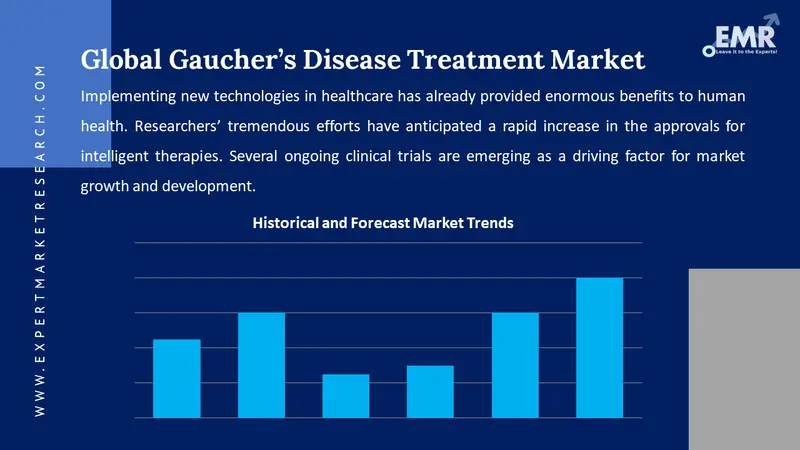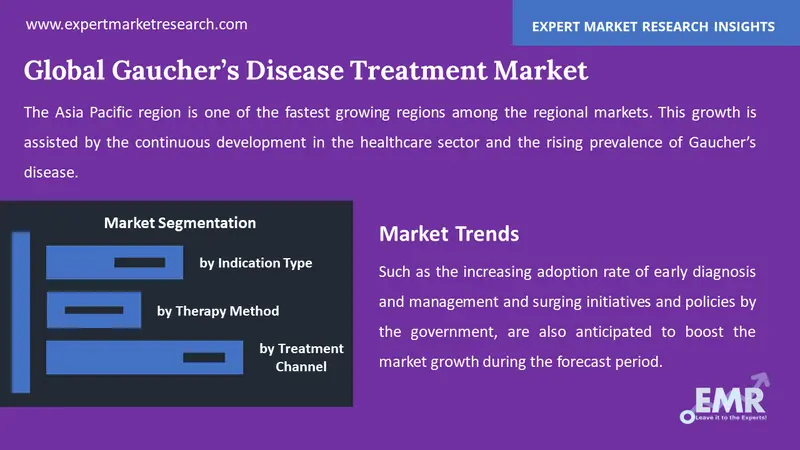
Consumer Insights
Uncover trends and behaviors shaping consumer choices today
Procurement Insights
Optimize your sourcing strategy with key market data
Industry Stats
Stay ahead with the latest trends and market analysis.
The global gaucher’s disease treatment market size attained a value of about USD 1.67 Billion in 2025. The market is expected to rise at a CAGR of 3.60% during the forecast period of 2026-2035 to attain a value of more than USD 2.38 Billion by 2035.
Base Year
Historical Period
Forecast Period
Compound Annual Growth Rate
3.6%
Value in USD Billion
2026-2035
*this image is indicative*
Gaucher’s disease is an autosomal recessive disorder, mostly occurring due to genetic causes. When both the parents are the carriers of Gaucher’s mutated gene, it mostly gets inherited by the offspring .
Gaucher’s disease is due to the accumulation of certain fatty deposits in specific organs. The accumulation causes the enlargement of these organs and thus, affecting their normal function. Gaucher’s disease mainly affects the liver and spleen.
The fatty substances concentrate in bone tissue, which can eventually lead to bone weakening and bone fractures. The body’s clotting ability is also affected due to the build-up of fatty deposits in the bone marrow.

Read more about this report - REQUEST FREE SAMPLE COPY IN PDF
Majorly, there are three types of Gaucher’s disease, Type I, Type II, and Type III. The signs and symptoms vary according to the disease’s type. In some cases, patients experience minimal or very few symptoms. The most common symptoms are irregular abdominal pain, painful fractures, bone weakening, skeletal abnormalities, bruising, and blood disorders.
The people living in the Central European and Eastern Jewish ancestry are more susceptible to Gaucher’s disease. The diagnosis of Gaucher’s disease is made using blood tests, genetic analysis, and imaging tests. Magnetic resonance imaging and dual energy-ray absorptiometry are also used to assess the disease’s severity.
The therapeutic strategy depends on the type of patient, type of disease, and age of the patient. Oral use of medications, like MIglustat and Eliglustat, is the initial approach of healthcare providers. Enzyme replacement therapy, spleen removal, and bone marrow transplant are some surgical interventions for managing Gaucher’s disease.

Read more about this report - REQUEST FREE SAMPLE COPY IN PDF
According to the Gaucher’s disease treatment market research report, the market can be categorised into the following segments:
Market Breakup by Indication Type
Market Breakup by Therapy Method
Market Breakup by Treatment Channel
Market Breakup by Region
The increase in the prevalence of the lysosomal disease is the key factor driving the growth of the market. Lysosomal disorders are inherited disorders caused by the abnormal accumulation of toxic chemicals in the body. Treatment strategies are required to eradicate the buildup of toxic substances, hence responsible for driving the market growth.
Gaucher’s disease treatment market is stimulated by the increased expenditure in the healthcare sector. The availability of raised funds by the government for research and development activities is also facilitating the market expansion. Gaucher’s syndrome susceptibility increase with age, and hence, the rising geriatric population can aid the growth of the market further.
Additional factors, such as the increasing adoption rate of early diagnosis and management and surging initiatives and policies by the government, are also anticipated to boost the market growth during the forecast period.
The North American regional market is projected to witness a significant share in Gaucher’s disease treatment market owing to the increased prevalence, rising R&D activities, and technological advancements.
The Asia Pacific region is one of the fastest growing regions among the regional markets. This growth is assisted by the continuous development in the healthcare sector and the rising prevalence of Gaucher’s disease.
The treatment for complete eradication of Gaucher’s disease is yet to be discovered. Current treatment interventions aim to alleviate the disease symptoms and improve the quality of living standards. The primary aim is to eliminate the accumulation of fat deposits and alter the defective enzyme responsible for causing Gaucher’s disease.
Currently Available Treatment Strategies: Oral Medications, Enzyme Replacement Therapy, and Surgical Interventions
The treatment for Gaucher’s disease depends on the type and severity of the disease. Daily monitoring needs to be done by the healthcare provider to assess disease progression and complications.
The initial treatment is carried out by incorporating medications that can be administered orally. The drugs act on the fatty deposits and hinder the production of fatty substances, thus helping manage Gaucher’s disease. Zavesca and Cerdelga are approved medicines for the treatment of this disease.
Enzyme replacement therapy is the most efficient therapy with plausible therapeutic applications. In this therapy, the defective enzyme is replaced with novel artificial enzymes. The intravenous route of administration is preferably used for taking these specific enzymes. This therapy needs to be performed after every two weeks.
The severe symptoms call for surgical or invasive therapeutic interventions. The two main approaches in the surgical process are spleen removal and bone marrow transplant. The replacement of damaged blood-forming cells with healthy cells is carried out in bone marrow transplants. Spleen removal is generally done when no other treatment options are left.
The novel treatments under the pipeline will help improve healthcare and the global economy. These new treatment strategies will majorly drive the growth of the global Gaucher’s disease treatment market.
Extensive research and development in the healthcare sector have benefitted in better understanding and awareness of the disease. The clinical trials will help discover novel therapeutic strategies for Gaucher’s disease.
The trials incorporating the innovations in Enzyme Replacement Therapy (ERT) are in the pipeline. Successful results will lead to the discovery of advanced ERT therapy that will be more efficient and economical.
Inculcation of advanced technologies in the diagnostic methods is anticipated to help in the early detection of disease. The novel neurodegeneration biomarkers are under evaluation, which seem promising in monitoring fatty deposits in the brain cells.
New oral medications are also in the developmental process and under clinical studies. Freeline Therapeutics, a leading key player, discovered a novel gene therapy product, FLT201, under Phase I/II clinical trial. The application of cell and gene therapy in Gaucher’s disease treatment is projected to have better prospects in the forecast period.
Implementing new technologies in healthcare has already provided enormous benefits to human health. Researchers’ tremendous efforts have anticipated a rapid increase in the approvals for intelligent therapies. Several ongoing clinical trials are emerging as a driving factor for market growth and development.
The report gives an in-depth analysis of the key players involved in Gaucher’s disease treatment market, sponsors manufacturing the therapies, and putting them through trials to get FDA approvals. The companies included in the market are as follows:




*While we strive to always give you current and accurate information, the numbers depicted on the website are indicative and may differ from the actual numbers in the main report. At Expert Market Research, we aim to bring you the latest insights and trends in the market. Using our analyses and forecasts, stakeholders can understand the market dynamics, navigate challenges, and capitalize on opportunities to make data-driven strategic decisions.*
Get in touch with us for a customized solution tailored to your unique requirements and save upto 35%!
The market attained a value of about USD 1.67 Billion in 2025, driven by the increased prevalence of the disease.
The market is likely to grow at a CAGR of 3.60% during the forecast period of 2026-2035 to attain a value of USD 2.38 Billion by 2035.
Based on the indication type, the market is segmented into Type 2, 3, and 3 Gaucher’s disease.
Based on the treatment channels, the Gaucher’s disease treatment market is categorised into public and private.
The different regions in the market are North America, Europe, Asia Pacific, Latin America, and Middle East and Africa. North America is anticipated to hold a significant share in the market during the forecast period.
There is no effective treatment for complete eradication but different therapeutic strategies help alleviate symptoms. Enzyme replacement therapy, oral medications, and surgical procedures have effectively treated Gaucher’s disease.
Increasing prevalence of lysosomal disorders, technological advancements, increased research and developmental activities, and better awareness are the driving factors for the market growth.
The key players in the market include Genzyme (Sanofi S.A.), Amicus Therapeutics, Inc., Novartis AG, Shire plc, Actelion Pharmaceuticals Ltd., Protalix Bio Therapeutics Inc., Johnson & Johnson, Takeda Pharmaceutical Company Limited, Abbott Laboratories, Aptalis Pharma Inc., and GSK plc, among others.
Explore our key highlights of the report and gain a concise overview of key findings, trends, and actionable insights that will empower your strategic decisions.
| REPORT FEATURES | DETAILS |
| Base Year | 2025 |
| Historical Period | 2019-2025 |
| Forecast Period | 2026-2035 |
| Scope of the Report |
Historical and Forecast Trends, Industry Drivers and Constraints, Historical and Forecast Market Analysis by Segment:
|
| Breakup by Indication Type |
|
| Breakup by Therapy Method |
|
| Breakup by Treatment Channel |
|
| Breakup by Region |
|
| Market Dynamics |
|
| Supplier Landscape |
|
| Companies Covered |
|
Datasheet
One User
USD 3,299
USD 2,969
tax inclusive*
Single User License
One User
USD 5,499
USD 4,949
tax inclusive*
Five User License
Five User
USD 6,999
USD 5,949
tax inclusive*
Corporate License
Unlimited Users
USD 8,199
USD 6,969
tax inclusive*
*Please note that the prices mentioned below are starting prices for each bundle type. Kindly contact our team for further details.*
Flash Bundle
Small Business Bundle
Growth Bundle
Enterprise Bundle
*Please note that the prices mentioned below are starting prices for each bundle type. Kindly contact our team for further details.*
Flash Bundle
Number of Reports: 3
20%
tax inclusive*
Small Business Bundle
Number of Reports: 5
25%
tax inclusive*
Growth Bundle
Number of Reports: 8
30%
tax inclusive*
Enterprise Bundle
Number of Reports: 10
35%
tax inclusive*
How To Order

Select License Type
Choose the right license for your needs and access rights.

Click on ‘Buy Now’
Add the report to your cart with one click and proceed to register.

Select Mode of Payment
Choose a payment option for a secure checkout. You will be redirected accordingly.
Gain insights to stay ahead and seize opportunities.

Get insights & trends for a competitive edge.

Track prices with detailed trend reports.

Analyse trade data for supply chain insights.

Leverage cost reports for smart savings

Enhance supply chain with partnerships.

Connect For More Information
Our expert team of analysts will offer full support and resolve any queries regarding the report, before and after the purchase.
Our expert team of analysts will offer full support and resolve any queries regarding the report, before and after the purchase.
We employ meticulous research methods, blending advanced analytics and expert insights to deliver accurate, actionable industry intelligence, staying ahead of competitors.
Our skilled analysts offer unparalleled competitive advantage with detailed insights on current and emerging markets, ensuring your strategic edge.
We offer an in-depth yet simplified presentation of industry insights and analysis to meet your specific requirements effectively.
Share